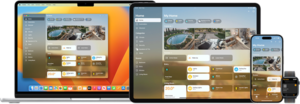
Apple TV is a digital media player and microconsole developed and marketed by Apple. It is a small piece of networking hardware that sends received media data such as video and audio to a TV or external display. Its media services include streaming media, TV Everywhere-based services, local media sources, and sports journalism and broadcasts.

iOS is a mobile operating system developed by Apple exclusively for its smartphones. It was unveiled in January 2007 for the first-generation iPhone, launched in June 2007.
iOS is a mobile operating system developed by Apple Inc. and was first released as iPhone OS in June 2007, coinciding with the launch of the first generation iPhone. iPhone OS was renamed iOS following the release of the iPad, starting with iOS 4. With iOS 13, Apple began offering a separate operating system, iPadOS, for the iPad. iOS is also the foundation of the newer audioOS and tvOS, and shares some of its code with macOS. New iOS versions are released every year alongside new iPhone models. From its launch in 2007 until 2010, this occurred in June or July, since then, new major versions are released in September or October. Since the launch of the iPhone in June 2007, there have been 17 major releases of iOS. The current major version of iOS is iOS 17, released on September 18, 2023.

The iPad is a brand of iOS- and iPadOS-based tablet computers that are developed by Apple, first introduced on January 27, 2010. The iPad range consists of the original iPad lineup and the flagship products iPad Mini, iPad Air, and iPad Pro.
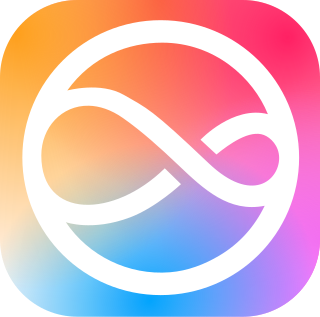
Siri is the digital assistant that is part of Apple Inc., including iOS, iPadOS, watchOS, macOS, tvOS, audioOS, and visionOS operating systems. It uses voice queries, gesture based control, focus-tracking and a natural-language user interface to answer questions, make recommendations, and perform actions by delegating requests to a set of Internet services. With continued use, it adapts to users' individual language usages, searches, and preferences, returning individualized results.
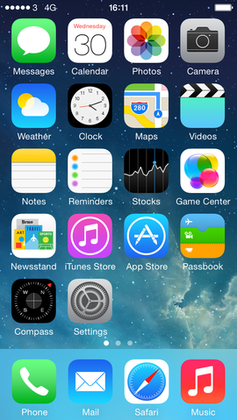
iOS 7 is the seventh major release of the iOS mobile operating system developed by Apple Inc., being the successor to iOS 6. It was announced at the company's Worldwide Developers Conference on June 10, 2013, and was released on September 18 of that year. It was succeeded by iOS 8 on September 17, 2014.

The iPad Mini is the first generation, known retrospectively as the iPad Mini 1, of the mini tablet computer designed, developed, and marketed by Apple Inc. It was announced on October 23, 2012, as the fourth major product in the iPad line and the first of the iPad Mini line. It features a reduced screen size of 7.9 inches (20 cm), compared to the 9.7-inch (25 cm) display on standard iPads at that time. Its internal specifications resemble that of the iPad 2, including its display resolution.
Thread is an IPv6-based, low-power mesh networking technology for Internet of things (IoT) products. The Thread protocol specification is available at no cost; however, this requires agreement and continued adherence to an end-user license agreement (EULA), which states "Membership in Thread Group is necessary to implement, practice, and ship Thread technology and Thread Group specifications."

tvOS is an operating system developed by Apple Inc. for the Apple TV, a digital media player. In the first-generation Apple TV, Apple TV Software was based on Mac OS X. Starting with the second generation, the software is based on the iOS operating system and has many similar frameworks, technologies, and concepts.
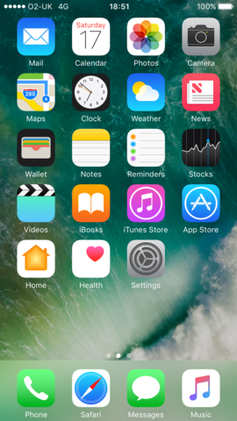
iOS 10 is the tenth major release of the iOS mobile operating system developed by Apple Inc., being the successor to iOS 9. It was announced at the company's Worldwide Developers Conference on June 13, 2016, and was released on September 13, that year. It was succeeded by iOS 11 on September 19, 2017.

Shortcuts is a visual scripting application developed by Apple and provided on its iOS, iPadOS, macOS, and watchOS operating systems. It allows users to create macros for executing specific tasks on their device(s). These task sequences can be created by the user and shared online through iCloud. A number of curated shortcuts can also be downloaded from the integrated Gallery.

iOS 12 is the twelfth major release of the iOS mobile operating system developed by Apple. Aesthetically similar to its predecessor, iOS 11, it focuses more on performance than on new features, quality improvements and security updates. Announced at the company's Worldwide Developers Conference on June 4, 2018, iOS 12 was released to the public on September 17, 2018. It was succeeded for the iPhone and iPod Touch by iOS 13 on September 19, 2019, and for the iPad by iPadOS 13 on September 24, 2019. Security updates for iOS 12 continued for four years after the releases of iOS 13 and iPadOS 13 for devices unable to run the newer versions. The last update, 12.5.7, was released on January 23, 2023.

iOS 13 is the thirteenth major release of the iOS mobile operating system developed by Apple for the iPhone, iPod Touch and HomePod. The successor to iOS 12, it was announced at the company's Worldwide Developers Conference (WWDC) on June 3, 2019, and released on September 19, 2019. It was succeeded by iOS 14, released on September 16, 2020.
iPadOS is a mobile operating system for tablet computers developed by Apple Inc. It was first released as a modification of iOS starting with version 13.1 on September 24, 2019. Before the release of iPadOS, iPads were released with iPhone OS, which was later renamed to iOS. New iPadOS versions are released every year mostly in sync with iOS, tvOS, and watchOS.
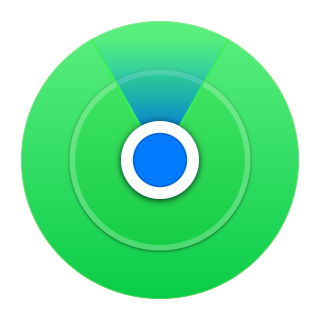
Find My is an asset tracking service made by Apple Inc. that enables users to track the location of iOS, iPadOS, macOS, watchOS, visionOS, tvOS devices, AirPods, AirTags, and a number of supported third-party accessories through a connected iCloud account. Users can also show their primary device's geographic location to others, and can view the location of others who choose to share their location. Find My was released alongside iOS 13 on September 19, 2019, merging the functions of the former Find My iPhone and Find My Friends into a single app. On watchOS, Find My is separated into three different applications: Find Devices, Find People and Find Items.
Matter is a freely available connectivity standard for smart home and IoT devices. It aims to improve interoperability and compatibility between different manufacturers and security, and always allowing local control as an option.
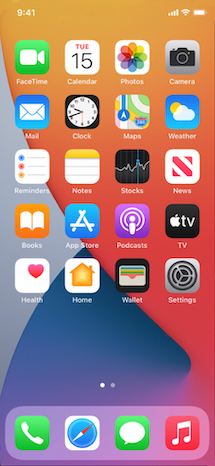
iOS 14 is the fourteenth major release of the iOS mobile operating system developed by Apple for the iPhone and iPod touch lines. Announced at the company's Worldwide Developers Conference on June 22, 2020 as the successor to iOS 13, it was released to the public on September 16, 2020. It was succeeded by iOS 15 on September 20, 2021.

iOS 15 is the fifteenth major release of the iOS mobile operating system developed by Apple for its iPhone and iPod Touch lines of products. It was announced at the company's Worldwide Developers Conference on June 7, 2021, as the successor to iOS 14 and released to the public on September 20, 2021.

iOS 16 is the sixteenth major release of Apple's iOS mobile operating system for the iPhone. It is the successor of iOS 15, and was announced at the company's Worldwide Developers Conference (WWDC) on June 6, 2022, alongside iPadOS 16, and released on September 12, 2022. It was succeeded by iOS 17 on September 18, 2023.

